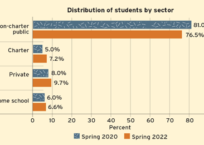
Written by Ruth Hoskins
In the age of COVID-19, many people are finding themselves in an unfamiliar educational camp with their children. Homeschooling is a subject that every parent with school-aged children is now talking about. But with so much information on homeschooling available online, many parents are overwhelmed and unsure of how to get started. The question I am asked most often is “Where do I begin”?
Below are three steps to getting a good start with homeschooling your children. Follow these three steps and you will be well on your way to having a successful homeschool year.
Step One: Write down why you intend to homeschool your children.
As you begin your homeschooling journey, one of the first hurdles to cross is one of the most important. Why are you homeschooling? If you do not spend some time with this question, and really get clarity on why you are deciding to take the homeschool journey, you might find yourself having difficulties down the line. I almost guarantee it. Please don’t skip this step.
People homeschool for a variety of different reasons. I am hard pressed to say that one reason is more noble than another. They are all different. The important thing is to know why you are doing it. Knowing why from the onset is going to be your guiding light, your north star. It will be what you come back to again and again. I don’t think that the initial reason that you homeschool will change. It might expand or shrink, but the root of the reason for homeschooling will remain.
Knowing why will also determine how long you will homeschool, and it will impact the curricular choices you make. I am a firm believer in homeschooling from kindergarten through high school. Many people choose a shorter time frame. Knowing how long you intend to homeschool will help you decide if you need to teach your children in a way that will keep in step with the local school, or if you have a broader window to set your own pace with your children.
You do not have to have everything determined at the onset of homeschooling, but you should know why you are doing it.
Once you decide why you are homeschooling, write it down and keep it in a file folder. You will have this as a reference when the challenges of teaching your children at home arise.
Below are a few questions to consider when thinking about your why:
1.) Am I homeschooling because I want to or because my kids are begging me to?
2.) Do I intend to homeschool throughout the compulsory educational years or just a fraction of them?
3.) Am I homeschooling because of my child’s educational needs (i.e., gifted, slower learner, different learner, etc.)?
4.) Am I homeschooling because of family life? I want our time to be our own, not dictated by our local school. We can take vacations when it is best for our family. We move a lot, and homeschooling can help to keep the educational process constant.
5.) Am I homeschooling because of religious reasons and convictions? I want to teach my children my faith and what that looks like in everyday life. I want to help my children navigate life’s complexities. I disagree with the liberal ideology that public schools are bringing into K-12 classrooms.
6.) Am I homeschooling because of bullying or some other unpleasant situation that is occurring in school?
You may find that you homeschool for a combination of reasons. There is no wrong reason. Just be clear on your reason.
Step Two: Know the homeschooling laws of your state. Print them out and file them in a convenient location.
It is amazing what peace of mind and confidence comes from knowing that you are meeting all of the requirements of homeschooling in your state. Confidence comes when you operate your homeschool freely within the confines of the law. Complete the requirements for your state. In Illinois, homeschools operate as private schools. Check out these frequently asked questions from the Illinois State Board of Education.
Home School Legal Defense Association (HSLDA) is another wonderful resource for checking out the homeschool requirements for Illinois, or any other state in the country.
Step Three: Choose a curriculum and get started.
There are so many methods of teaching, and curriculum choices, that it is very easy to get overwhelmed. The important thing to remember is that the curriculum choice that you decide today is not something that you have to stick with forever. The curriculum is a tool to help you reach your goal and, as with all tools, if one does not do the job, you choose another.
Here are a few things to consider when choosing a curriculum:
First, think about your level of involvement. Do you want an online teacher (school at home) or are you going to be the hands-on teacher, leading the lessons and learning objectives? Do you want to create the lesson plans, or would you like that worked out for you? Do you plan on grading the work yourself and thus will need answer keys, or will you look for a way to outsource that? Will you be keeping records, grades, and creating transcripts? (This is important for high school students.)
Next consider how you would like to have your homeschool structured. Do you prefer a textbook and workbook learning environment, or an all online learning atmosphere. Are you comfortable seeking and creating the learning objectives for each grade, or would you rather follow a plan that has the learning objectives all laid out for you by grade?
What is your budget?
Once you know what you are looking for, search homeschool curricula online with those markers, and choose 3-4 different publishers. Go to their websites and take a look at a few sample lessons. Check to see which publishers have what you need, and then choose one. You are not going to choose wrong. Once you try something, use it, and if possible, use it for the entire year. Then evaluate what worked, what did not, and choose again the next year. It’s that simple.
Here are a few companies to get you started: Abeka books, Time4learning, Saxon, Pearson Online Academy, Calvert Homeschool, and Khan academy. There are hundreds to choose from. Set your sights on just a few to keep from getting overwhelmed. Also, keep in mind that if you are teaching multiple ages, some subjects can be taught together using a Unit Study method of teaching.
Spend some time determining what you are searching for first, and this will help to keep you from venturing into the curriculum world only to come out overwhelmed, discouraged, and defeated. What you choose today may not be what you use next year. That’s okay.
One more thing about choosing a curriculum. There is a lot of talk about understanding what your child’s learning style is before choosing a curriculum. Although helpful, don’t let not knowing stop you from moving forward. You do not have to have everything worked out at the onset of homeschooling.
You can teach your children at home. Understand that you will have good day and not-so-good days. If you prepare with the above steps, you will be on your way to having more good homeschool days than not throughout the year.
Ruth Hoskins is a veteran homeschooling mom, who along with her husband, taught their children from birth through high school. They did this without having an educational degree or certificate. She says that it was one of the most rewarding and challenging endeavors she’s had in her life. Ruth wants to encourage others who have a desire to homeschool their children to go for it. The benefits are so much more than academic achievements.
Check out Ruth’s blog: Homeschooling As A Lifestyle for more information.































